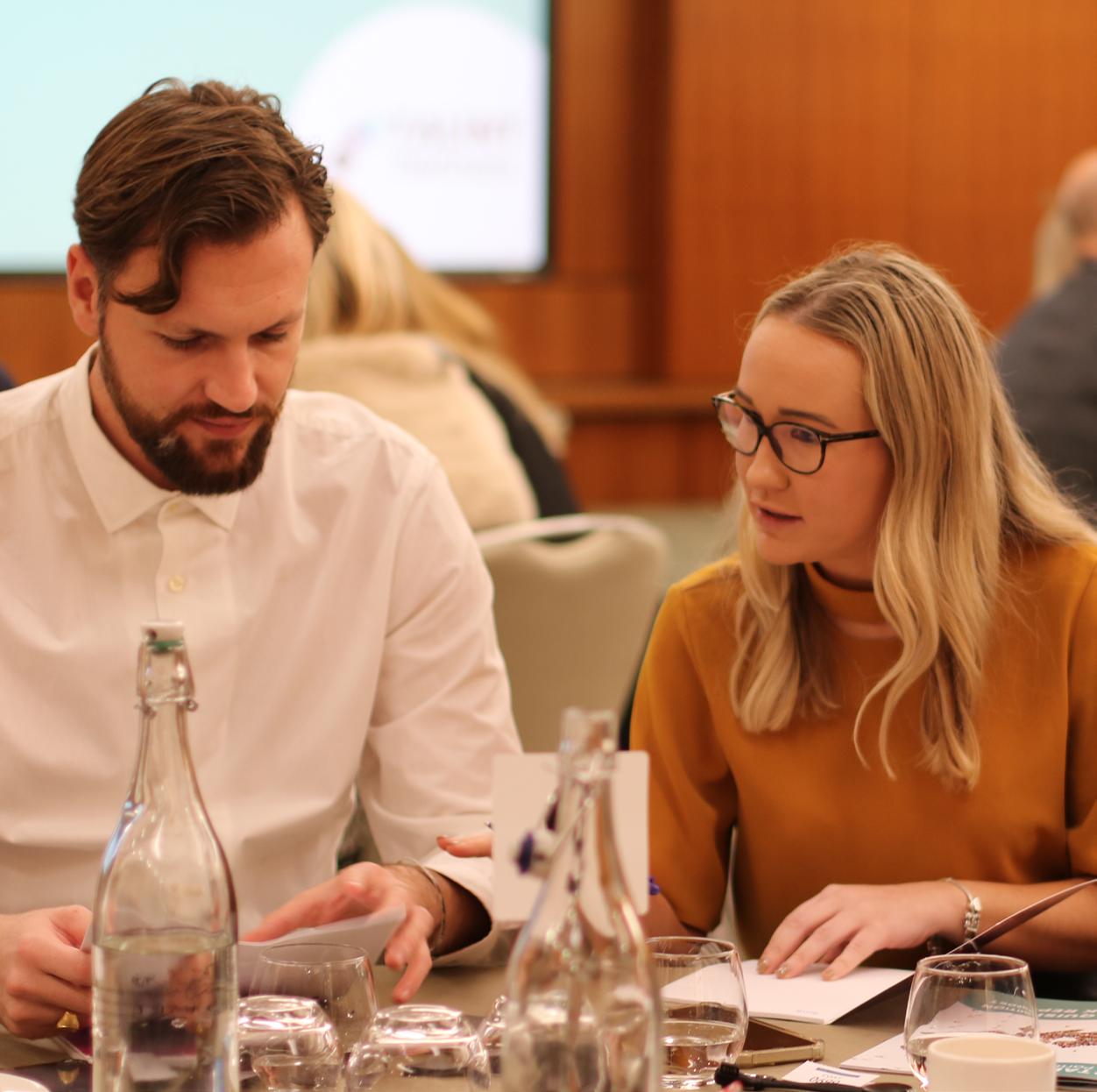




As I opened the door to 2023 with trepida�on –I mean, who knows what could be lurking there considering the events of the last three years? –I decided not to take part in the ‘new year, new me’ movement. Phrases like ‘Let’s start as we mean to go on’; ‘Let’s hit the ground running’ and ‘Now that we’ve all had a chance to recover’ have li�ered my social media feeds and all make me feel like things inevitably will go downhill, quickly. I don’t want to begin the year thinking I’ll be burnt out in a few months.
The last few months of 2022 were stressful to say the least, as costs skyrocketed, Big Tech announced massive redundancies and companies across the globe announced hiring freezes and cost cuts. I have no doubt that this year is going to be tough, but also, that’s old news.
Let’s talk about new news! Organisa�ons are s�ll hiring despite economic uncertainty, and that tells me that there will be growth this year – and not only to our gas bills. The government and employers have major growth plans in place for 2023, and this could keep candidates in the talent scarce market’s driving seat.
On the other side of that coin, I predict less churn during the year as employees hang on to the roles they have because of the turbulent market. Exit The Great Resigna�on!
Enter The Great Reten�on! And this creates a fantas�c opportunity for employers to become crea�ve when it comes to upda�ng reten�on schemes. Whilst LinkedIn data for the UK has
revealed that the number one thing candidates are a�er is a higher salary, there are so many innova�ve methods that employers can use to keep their exis�ng talent. For example, greater flexibility, internal mobility, company culture, and maybe the odd free lunch on a Tuesday would be cool, too.

Speaking of LinkedIn, did you know that it has been given a 1.5 star ra�ng on TrustPilot? I don’t know about you, but the older I get the more �me I spend reading online reviews. Need a new chest of drawers? Read 100 reviews on Amazon. Need a new hair stylist? Read 50 reviews on the community Facebook page. Why should it be any different when it comes to the tools we use to do our jobs well? For the first lead feature of the year from our team, please read our ar�cle, ‘What’s the Point of LinkedIn?’, on page 16.
As usual, we’ve curated content packed with the industry’s most per�nent insights and trends and packaged it beau�fully for you in our magazine. We grew tremendously last year and this year we’re going to work �relessly to make something that’s really good, really great!

TALiNT Partners brings together a global network of leading employers and solu�on providers to make be�er talent and technology decisions by providing intelligence, insight and peer-to-peer networking that drives quality, innova�on and improves inclusion across the talent ecosystem.
Published by Talent Intelligence Partners Ltd Casa Court, Great George Street, Godalming GU71DX www.talintpartners.com
Editorial, news and features: debbie@talintpartners.com Adver�sing and sponsorship: andy@talintpartners.com Design: annabelle@talintpartners.com Layout and design: New Media Design Agency www.newmediadesign.co.za













The year 2022 saw TALiNT Partners host 100 events which included the biggest one yet – the Talent and TIARAs in the US at the end of the year. If you did not see your fabulous face in the pages of TALiNT Scene in 2022, be sure to a�end our host of informa�ve and insigh�ul dinners, roundtable discussions and conferences here. You’re guaranteed to be seated next to fellow industry leaders and colleagues who will share both insights and challenges faced in the market. It’s a great �me to network, eat delicious food and gain a bird’s eye view of the talent ecosystem.
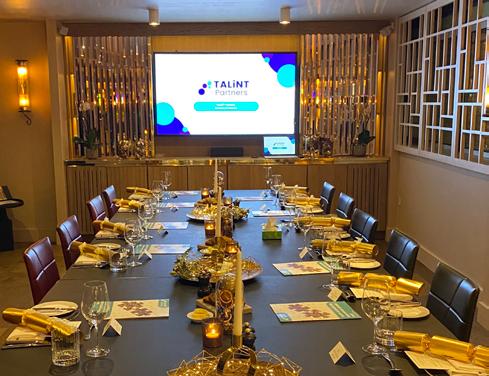
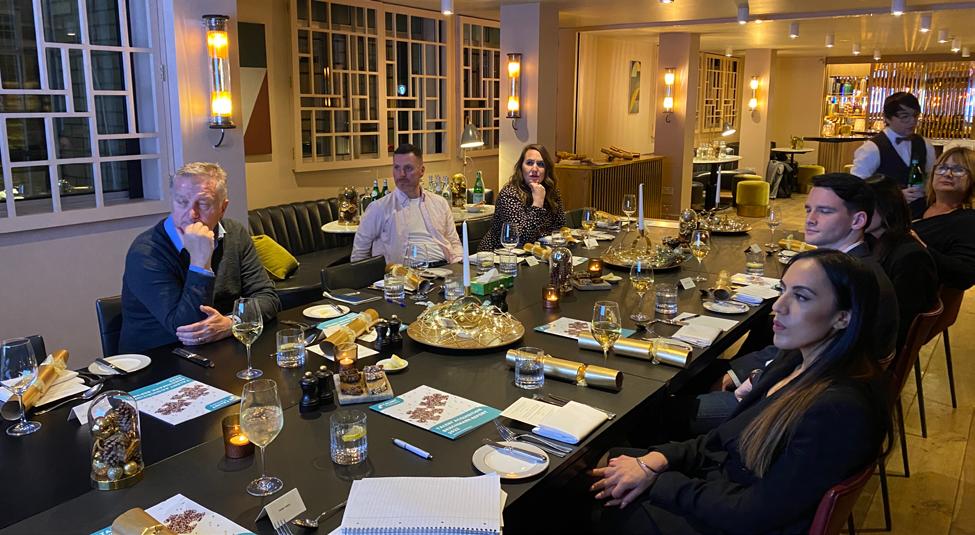
7 December
London
TA Leaders Dinner: Talent planning for an uncertain 2023. In the opulent setting of the Marylebone Hotel in central London, TALiNT Partners and Eightfold.ai looked at the challenges of preparing for the unexpected in workforce planning, gap analysis and critical skills retention to meet organisational priorities in an uncertain and potentially volatile market next year. We also pulled crackers and wore Christmas hats.
Dinner and Debate. Back to the Marylebone (a new favourite it seems!) in partnership with iCIMS to debate the highs and lows of recruitment in 2022 and what leaders should be priori�sing for resilience and success in 2023. The
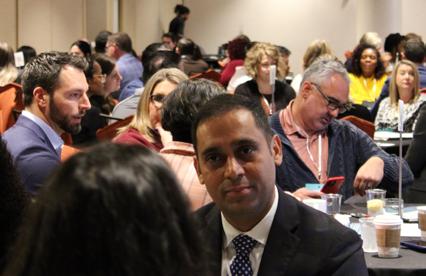

dreaded ‘R’ word came up too (‘Recession’ in case anyone hasn’t been reading the news) and how it will impact the industry in 2023 and which sectors will be most resillient. This event was the 100th event hosted by TALiNT Partners in 2022. We can’t wait for the next 100!
Talent and TIARAs Conference and Awards. TALiNT Partners flew across The Pond to Atlanta to host our first two-day event and conference: Talent and TIARAs! TALiNT Partners brought together the cream of the Talent Acquisi�on community to share what we have learned from the complex and varied talent challenges of 2022 and look forward to what’s ahead in 2023.
We’re already planning this year’s Talent and TIARAs in June. Watch this space!
To finish the two-day extravaganza with a flourish, we crowned our TIARA Talent Acquisi�on and Talent Tech Stars champions in a gala celebra�on dinner!

The government’s 2022 announcement last year that employees can request flexible working from day one along with evidence that shows flexible working arrangements improve employee well-being has meant that hybrid work is increasingly sought after.

Office space provider Work.life looked at job listings on LinkedIn to establish which industries offer their staff the most flexible working options. They looked at who posted the highest number of jobs in the onsite, hybrid and remote categories and how many vacancy adverts included the word ‘flexible.’
According to their research:
The so�ware industry topped the list as the most flexible industry with 28% of adver�sed jobs being fully remote. PR, as an industry, offered the most hybrid posi�ons at 60% with only 16% of listed jobs in the PR industry suggest they are flexible. A third of PR roles are adver�sed as purely onsite. Educa�on is one of the industries that offer the least flexibility at just 15%.
Alex Evans, MD of TALiNT Partners, said, ‘It’s interes�ng to see job ads for recruitment with remote, hybrid and flexible offers similar to educa�on, indica�ng that most employers in staffing want their talent back in the office.’

Amazon announced its plans to close three warehouses in the UK and open two new major fulfilment centres. This decision may impact 1,200 jobs, but the company says all employees will be offered roles at other exis�ng Amazon loca�ons. The proposed closures include warehouses in Hemel Hempstead, Doncaster and Gourock, in the west of Scotland. The new sites, which are planned to open in Peddimore in the West Midlands and Stockton-on-Tees in the North East, are expected to create 2,500 jobs over the next three years.
A spokesperson for Amazon stated that the company is always evalua�ng its network to ensure it meets the needs of the business and improves the experience for
its employees and customers. The closure of these sites, as well as the opening of new ones, is a part of this ongoing process. They also highlighted that employees affected by the closure will be offered the opportunity to transfer to other facili�es.
The union representing some of the workers at the Hemel Hempstead site expressed disappointment with the decision and is sceptical about the possibility of finding alternative work for all affected employees. The company has acknowledged that the Gourock location has less scope for alternative work within Amazon and says they will offer retraining and reskilling opportunities to affected employees.
With the shrinking UK economy, high infla�on and increased interest rates affec�ng consumer spending, fear of the recession is taking hold among small business owners. This is according to new SME Outlook 2023 research from the small business lending company, iwoca.
Number of SMEs saying that recession is their main concern
When looking at hiring in 2023, small business owners expect to limit hiring in the next 12 months. Seventy-nine percent of small business owners expect to employ the same number of workers this year as in 2022. Only 7% expect to employ more staff this year, 2% less than last year.
Number of SMEs saying increased business running costs are a worry
Believe that they will personally be worse off in 2023

SMEs reluctant to hire more staff in 2023
New findings released by Experis, the global IT professional resourcing organisa�on, revealed that the UK is harbouring an untapped reservoir of talent with huge poten�al. However, employers need to do more to communicate the opportuni�es and benefits of a career in tech alongside an expansion in the right training. Internal mobility is key in the fight for talent.
More than a quarter of UK adults wish they worked in the tech sector – while nearly one in four would consider taking courses with the aim of moving into the industry. With this sector con�nuing to face a significant skills gap in high-demand roles from so�ware development to data engineering, this news is par�cularly encouraging for both industry employers and prospec�ve candidates.
The research revealed that the greatest factor driving people towards a career in
UK adults who wish they had access to tech subjects at school
tech is pay, with 39% of UK adults believing the tech industry offers be�er pay than their current industry.
However, the survey details some confusion with nearly a fi�h of UK adults (19%) believing that a career in tech and a career in IT is the same thing ¬– with more needing to be done by employers and industry to raise awareness of what such a career really is.
Almost half of those surveyed (41%) studied tech related subjects at school, but nearly as many UK adults wish they had been given access to more tech subjects and training at school. This indicates that businesses and training providers in tech and IT could leverage more homegrown talent across the UK by better highlighting the benefits of working in the industry and making sure that any skills and training programmes are effectively promoted.
UK adults believe the tech sector offers be�er pay
UK adults believe careers in tech and IT are the same thing
Twenty-seven percent of UK adults wish they worked in the tech sector

So, in response to those needs, TALiNT Partners has put in place a Global Advisory Board (GAB) to create an exclusive group of senior leaders who, alongside our TALiNT Partners leadership team, share market insights, influence talent strategy and act as a sounding board to test ideas and share these with our members.
The Board is led by Declan Sla�ery, Chair of our Global Advisory Board, and he recently laid out its purpose and goals. ‘Our Board

will also enable members to leverage the mee�ng agendas and content to help shape deployment of their own strategies whilst having direct access to TALiNT Partners’ senior execu�ve team and thought leadership experts.
At TALiNT Partners we have always been progressive and con�nue to evolve what we do to meet the needs of our members. Therefore, as the market leader in bringing together a global network of

It’s fair to say that talent acquisi�on (TA) leaders across the world would call out the constantly evolving world of work as well as the agility needed to build the right strategies as top of the list of importance when looking into the next 12 months. And so o�en those challenges and designing solu�ons to meet them is something they face alone.Declan Sla�ery Head of Employer Programme and Chair of Global Advisory Board, TALiNT Partners
‘I felt the mee�ng was so insigh�ul. It was so helpful to work, listen and share with such a diverse and open group of individuals who are all sharing the same challenges as me even though I’m across the Atlan�c in the US. I’m really looking forward to what else I can learn and contribute to on future boards.’

leading employers and solu�on providers to make be�er talent strategy and technology decisions, we are eager to grow and share our ability to provide market intelligence, insight and peer-topeer networking that drives quality, innova�on and improves inclusion across the talent ecosystem.’

Declan went on to say, ‘We launched our first board meeting in December, with members from the UK and USA
representing industries that include consumer electronics, retail and investment banking, pharmaceuticals, luxury goods, software development and global communications. The depth of conversation was incredible with some big key themes emerging especially around ways of working, market uncertainty, internal mobility and DE&I which perhaps not surprisingly, resonated across all our board members, both in the UK and USA.’
‘There are so many sides to a TA leader’s role and being part of the GAB provides a unique space to not only test my own thinking and strategy but to also understand how other leaders are approaching the same global challenges. I’m also really looking forward to helping TALiNT Partners shape their proposi�on, which I know will bring benefits to the wider TA community.”
Our Advisory Board will run right through 2023 and each mee�ng’s agenda will be developed in consulta�on with the board members and will typically include:
• Facilitated discussion on strategic trends and industry issues.
• Keynote on the most relevant topics to be covered during the mee�ng.
• Networking platform for member peer interaction.
• Early insight into future TALiNT Partners’ strategic ini�a�ves and specific member use cases of interest to the group.
Our Global Advisory Board is a unique and rich reservoir of cri�cal insights for TA leaders that we will no doubt con�nue to share, but there’s also the opportunity for TA leaders to become involved and be at the forefront of strategic thinking by joining our Talent Leaders Membership Programme. And you can find out more about how that works by contac�ng declan@talintpartners.com.
‘Being a member of the board is really valuable to me. Not only does it provide a dynamic forum to explore shared challenges and solu�ons, it’s fantas�c to see how TALiNT Partners use it to ensure they are focused on the most impac�ul current day events and topics for their leadership community.’






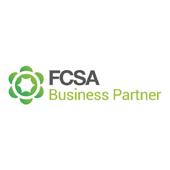


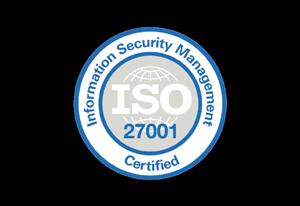
LinkedIn has been an almost unalloyed success since it first crept into our consciousness, in most cases in and around 2005-6, and has become a truly indispensable tool for anyone in the professional recruitment world – be it an employer, a candidate or a recrui�ng firm. And unlike many other social media pla�orms it has remained pre�y much scandal and controversy free. Sure, there have been the occasional gripes around the introduc�on of new features and the withdrawal of old ones, and, as with all so�ware services, pricing, but in the scheme of things, it has broadly stayed true to its mission.

It’s takeover by Microso� in 2018 led many in the industry to ques�on its future direc�on, but, again by and large, it has stayed on course and has evolved as the broader world of talent has evolved.


But, in recent years, and the last twelve months especially, it’s not just been us and our colleagues here at TALiNT Towers who
have detected an increasing blurring of the lines between LinkedIn and other purely social networks.
Without having to look too hard, we found lots of recent posts ranging from the banal – I like hip-hop, it’s my ruby anniversary, my first blind date, I ran a marathon – to the tragic and heart-breaking – losing a child, suicide, tales of abuse and so on.
Some of them are narcissis�c beyond belief. ‘Have you missed me?’ or ‘I’m back!’. We can assure you no one no�ced you went away.
Some�mes the more personal stories will try and make a relevant point, ‘why am I telling you this...?’, but most don’t. And whilst you would have to be incredibly hard-hearted not to empathise with many of the personal posts, there is s�ll a ques�on – why is this on LinkedIn?
The strength of LinkedIn has always been its focus: ‘I need to hire someone/I need to
Global Head of Talent Acquisi�on at Kerridge Commercial Systems
find a new job and/or get be�er at the one I have.’ The danger now is that focus becomes lost in a �de of irrelevant content.
In order to triangulate our hypothesis, late last year, we decided to do some research of our own. Research began with a quick Google search: ‘What is the point of LinkedIn?’. TrustPilot reviews came out on top with reviewers giving LinkedIn one and half stars… a poor rating, indeed.
Following that, we approached a number of trusted, senior contacts across the talent ecosystem – employers, large staffing firms and outsourcing providers and asked them for their views.
Alison Westwood
Head of Talent Acquisi�on at Zenith Vehicles

Here’s what we found.
Unsurprisingly, LinkedIn continues to be the go-to destination for candidate identification and market mapping and remains the pre-eminent tool for doing so. But leaders also see the value in helping them to build their own brand and network.
Likewise, the cons were pre�y much as we expected with the ‘noise’ of increasingly irrelevant content being seen as the biggest issue by some margin.

Pros:
• Strong reach for finding candidates and market mapping
• Real-�me informa�on for finding people with certain skills and at certain companies
• Allows for personalisa�on when reaching out to individuals
• Keeps personal brand relevant in the market
• Can be used to iden�fy people across a wide range of geographies.
Cons:
• Increasingly becoming a general social media pla�orm with less business-related content
• May not have as strong of an ROI as it used to be
• Candidates may be spammed and senior personnel may be withdrawing from or increasing privacy on the pla�orm
• Noise on the pla�orm makes it difficult to cut through and reach the desired audience
• Does not provide insight into the calibre of candidates
• Informa�on on the pla�orm cannot always be trusted
• May give people a license to create their own reality and portray themselves in a falsely posi�ve light
• Constant approaches by salespeople can be annoying and intrusive.
LinkedIn Recruiter is seen as pre�y much essen�al for recruitment ac�vi�es. It was noted though that this tool is a generalised global tool and considering TA teams are now looking across borders, LinkedIn’s reach can be hard to beat.
LinkedIn Insights was also said to be useful but not seen as essen�al, with other tools increasingly being used as part of an overall approach. Interes�ngly enough, Ma� Pycock, Global Head of Talent Acquisi�on at Kerridge Commercial Systems, said that there are other solu�ons coming on to the market that are cheaper and cover more data points so those new developments could be ones to watch out for.
The responses here were fascina�ng: for reach and visibility in professional recruitment LinkedIn is s�ll essen�al. Interes�ngly, there was a view that a lot of users s�ll don’t know how to get the most from the pla�orm.
Alison Westwood, Head of Talent Acquisi�on at Zenith Vehicles, believes that she could possibly do without it in business but was unsure if there’s anywhere else to go that has the same mass of data to mine.
James Gordanifar, Global Head of Talent Acquisi�on, Early Careers at WTW, said that since they don’t pay for it, they feel they do get value from it. ‘I have to wade through all the nonsense to get to the value, but it is on there if you look for it. I also think it is good value because I have had relevant approaches about jobs and networking opportuni�es. It’s just that 90% of it is useless nonsense,’ he said.
Ma� Pycock commented further that while he could probably do without LinkedIn, he’d possibly be missing out on some of the useful content, that it would be hard not to be present on this channel anymore.
This comment poses an interes�ng scenario. What was TA life like before LinkedIn? And if you’re not on LinkedIn, do you even exist? What, if anything, is its alterna�ve?
When the respondents to our survey were asked if they see LinkedIn as good value or not, we received a mixed bag of responses, but the majority of answers leant towards sta�ng that it’s overpriced for what you get. One of our contributors went so far as to say that the price goes up every year with li�le to demand the increase in terms of new func�onality.
Some said that the online training made available is incredible but that it came with a he�y price tag. As with every investment an organisa�on makes, if there’s no ROI, it’s best to bin it.
One head of HR in the broadcas�ng industry said exactly that. ‘I did try LinkedIn for training online as it has a huge level of material but pulled away from it as people didn’t make best use of it versus cost.’
One respondent stated that while LinkedIn outperforms other job pla�orms and forms a massive percentage of TA spend, that it is not good value for money at all. He said that it is star�ng to lose its a�rac�on, in par�cular for certain groups such as development/programming roles, graduates and early careers roles, as well as low-level posi�ons.
Ashley Ryall, Founder and Principal at Untap Social said that many users haven’t caught on to the fact that LinkedIn has become a news pla�orm! ‘Over the last two years, they’ve brought editors, journalists and content experts onto their payroll. The biggest value LinkedIn offers is its ability to help us become good thought

leaders. With LinkedIn news stories and trends, they expect to gain momentum, we can posi�on ourselves with unique points-of-view about topics that ma�er and facilitate relevant, important dialogue with our audiences. And that’s just with the free version.’
Our commentators suggest a need for LinkedIn to focus on crea�ng a more professional and curated pla�orm. This includes removing unnecessary content, be�er integra�on with social media and increasing visibility in schools and colleges to educate young professionals on the benefits of building a personal brand on the pla�orm.
Addi�onally, there is a call for stricter protocols around what is allowed to be shared, a way to validate content and a simplifica�on of the pla�orm to cut down on noise and overs�mula�on. There is also a sugges�on for the support team to advise clients on how to make the most of the pla�orm and for licence holders to have more transparency on what training their teams have undergone.
Adam Hawkins, Head of Search and Staffing, EMEA & LATAM, LinkedIn said, that they recognise that there has been an increase in social cha�er on the pla�orm as the pandemic was a catalyst for people sharing more personal experiences as work and home lives increasingly blurred. But he believes there is a shi� away from the personal posts to more knowledge sharing and encourages users to take part in these useful conversa�ons.
Over the last two years, they’ve brought editors, journalists, and content experts onto their payroll. The biggest value LinkedIn offers is its ability to help us become good thought leaders.
LinkedIn is s�ll very much a well-respected, incredibly useful (borderline essen�al!) tool for employers and recruiters alike but seems in danger of losing its way a li�le bit. The vast majority of the niggles its customers have are not dissimilar to those of many other global so�ware providers (too expensive, func�onality isn’t exactly what I want, etc., etc.) but what is clearly troubling many is frankly the increasing levels of social media-type noise. And here’s the thing, LinkedIn isn’t a social service, it’s a commercial enterprise with a pre�y clear focus and generally the people genera�ng the noise are not paying customers. A right to free speech doesn’t mean a right to free pos�ng!
It’s not for us to say whether this can be solved by tweaking the algorithm or by

introducing clearer guidelines or even a code of conduct. Yes, a simple Google search will tell you in order to clean up the noise on your feed you should clear out your contacts list, follow different pages and people and so on. But it appears that an awful lot of people would like it to do something.
At the end of it all, LinkedIn does own the highest market share. What are the alterna�ves? Going back in �me to the old school rolodex won’t cut the mustard. But it does feel as if this means we’re all in a rela�onship with LinkedIn because there’s just no one else to date.
As the breakthrough of OpenAI’s ChatGPT, game changers can come seemingly out of nowhere. LinkedIn has a tonne of goodwill and customer loyalty, don’t blow it.
L e v e l U P o f f e r s d i v e r s i t y - d r i v e n a n d a g i l e w o r k f o r c e s o l u t i o n s t o h e l p o r g a n i s a t i o n s u n l o c k e x p e r t t a l e n t q u i c k l y a n d e f f i c i e n t l y .
l e v e l u p h c s . c o m e m e a t e a m @ l e v e l u p h c s . c o m l e v e l u p h c s


s :
R e c r u i t m e n t P r o c e s s O u t s o u r c i n g ( R P O )
R e c r u i t m e n t o n D e m a n d
C o n t i n g e n t W o r k f o r c e M a n a g e m e n t
H R A d v i s o r y S e r v i c e s
FFor TALiNT Partners’ final TA leaders dinner of 2022, on 7th December we found ourselves in the luxurious Long Room at the Marylebone Hotel in London for a talent acquisition dinner in partnership with Eightfold.ai. The main topic of discussion? Talent planning for the uncertain year ahead. With the UK’s third Chancellor announcing a mini budget and major tech companies making mass redundancies, TA leaders were left feeling flummoxed about what to expect in terms of hiring and workforce planning in 2023.

Considering just weeks prior to this last supper, the UK’s third Chancellor of the Exchequer, The Rt Hon Jeremy Hunt MP, had announced the mini budget, talk inevitably turned to its contents and the expected ramifica�ons thereof. Slowed economic growth and the cost-of-living crisis caused by high infla�on and rising gas prices seemed to have put the brakes on hiring in the final months of 2022, with many heads of TA deciding to hold off hiring ‘for the �me being’.
Not only did the mini budget cause ripples (perhaps rougher water than mere rippling) in the TA industry, but the recent announcements of mass redundancies in the tech sector by Microso�, Twi�er, Meta and the likes dominated the conversa�on too. Were the mass redundancies a sign of the �mes? Or simply an act to balance the hiring scales in the tech sector following the sonic boom of hires during COVID-19? Regardless, the TA leaders round the table were at a loss as to what to expect with hiring numbers and workforce planning in 2023, with some saying they feel it’s best to watch and wait before making harsh decisions. A�er all, the government and many organisa�ons s�ll ac�vely have plans for growth in the coming years, so to put a complete freeze on new hires seems premature.
But the conversa�on didn’t stop there. The group also delved into the topic of ‘rejected candidates’, or those who narrowly missed the cut for a job but showed plenty of promise. One TA leader pointed out the negative connotations of
the word ‘rejected’ and emphasised the importance of considering these candidates for future roles within the organisation. They may just need a little extra training to round out their skillset. In a market where talent is scarce, it seems obvious that candidates who made second or third place should be considered as an untapped talent pool for TA leaders.
The discussion highlights the direct impact of economic and employment market shi�s in the challenges of talent acquisi�on leaders, and the cri�cal need to regularly access and assess accurate insight to avoid being blind-sided.

To round off another successful TALiNT Partners dinner, we pulled crackers, donned Christmas hats and read out the jokes found inside them. Sparsho�, Head of Insight and Research at TaliNT Partners, hosted an excep�onal evening and we are looking forward to many more in the coming year.


TA leaders round the table were at a loss as to what to expect with hiring numbers and workforce planning in 2023.
TI had the pleasure of si�ng down with TIARA Talent Solu�ons Awards judge Alison Westwood, Head of Talent Acquisi�on at Zenith Vehicles. With the UK economy contrac�ng and talks of the recession, Alison talked about how to effec�vely plan demand and manage internal mobility.
TI: What, in your opinion, has been the biggest changes/shi� in the RPO space in the last 12 months?
AW: The expansion of the augmented RPO services. Offering quick, short-term solu�ons for corporate clients rather than just big scale solu�ons that are offered in response to total outsourcing and RFPs.
TI: How do you think the impending downturn will affect hiring volumes?
AW: I believe by the end of Q1 we will be seeing only key roles replaced, a lot less new roles and a rapid slowing of the recruitment volumes we have seen in the last 12 months.
TI: How has technology supported TS teams during the massive increase in hiring volumes seen this year?
AW: I actually think technology has been less important with a key focus on personal contact to fill effec�vely. Technology is only ever an enabler; however, we have seen
more innova�on in areas such as RPA/chat bots/AI etc. to allow for be�er and more personal engagement via tech.
TI: Reed Talent Solu�ons won the Diversity and Inclusion Award at last year’s TIARA Talent Solu�ons Awards, for which you were a judge. Their workforce solu�on in partnership with NHS Blood & Transplant was designed and implemented to recruit diverse plasma donors. What about the entry stood out for you?
AW: This is a notoriously difficult sector in which to be effec�ve in any way. So, to actually deal with such a large scale project and increase the ethnic diversity by 45% is outstanding. There are not many RPOs that would ‘bite off ’ such a challenging campaign at such a difficult �me for the care industry. I also know that NHSBT have previously suffered through adverse publicity in the area of diversity so I know how important this will have been to them. A really great result.
TI: What do you predict will happen to demand levels in 2023? The millionpound ques�on.
AW:With my crystal ball I predict that demand levels for new roles will decrease pre�y substan�ally by the end of Q1 2023. I s�ll think that remote working has made applying for new roles easier for candidates so I think that a volume of ‘churn’ roles (The Great Resigna�on) will remain but at a lower rate than in 2022.
TI: What are the greatest challenges facing talent leaders in the coming year?
AW: a) Keeping their own teams to a reasonable size as recruitment levels drop. Many TA teams have been running ‘hot’ over the past year and companies may forget that quite quickly as they look to make cuts in roles that are seen as overheads. So smaller teams could well end up dealing with what are quite high numbers.
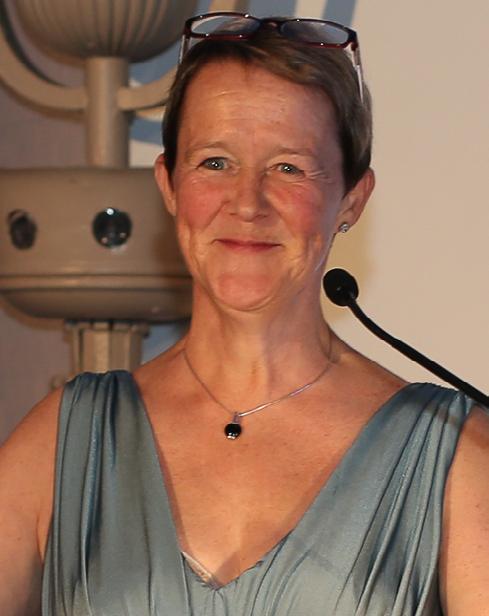
b) Keeping quality talent in their own organisa�on if salary increases/promo�ons are not available.
c) Dealing with a workforce that may have been overpromoted, taken into roles that are more demanding than the capability of those they recruited at the salary they recruited them for.
TI: In last year’s TIARA Talent Solu�ons Awards, there was much focus on DE&I across the board. What are you expec�ng to see in this year’s entries?
AW: Focus on how to retain talent and internal talent management/mapping. I think the focus on DE&I will remain but with some significant focus on younger genera�ons/engagement. I also think there will be greater focus on well-being and different reward strategies coming into play.
TI: Let’s talk about internal mobility. The market is s�ll experiencing mass skills shortages and employers o�en ‘miss’ their internal talent. How can RPOs facilitate internal mobility and be renumerated for it?
AW: There has to be a strategic conversa�on about how much the organisa�on genuinely buys into internal mobility. A lot of companies talk about it but don’t work out what that means. For example, these are some of the ques�ons that should be asked and answered: Is it making career pathways clear? Is it allowing free access to all roles? Is it talent and succession mapping? Is it using talent for secondment opportuni�es and how does it get planned so that you are not robbing Peter to pay Paul?
Once you have that agreed you must get the client to understand that it takes �me and is not a ‘free resource’. The only way is to show that there is real value in the service you provide. Providing workshops to encourage cross func�onal applica�ons for roles; crea�on of talent and succession plans with organisa�ons that maps across all areas of the company...it’s a tricky dynamic.
TI: How can data support successful demand planning?
AW: Demand planning has to start with demand. 1) Where are we now? 2) Where do we want to get to? and 3) What scenarios might affect that final outcome? For example, sales going down, costs going up, changes to technology…
Most organisa�ons only work out 1, with a very short-term view on 2 and li�le thought on 3.
You can overlay a�ri�on and market forces data to help with how hard it might be, how much re-work or re-fill might be required, but without the organisa�on buying into 1, 2 and 3 above, the rest is pre�y meaningless.
TI: Tell us why you value being a judge at the TIARAs and what sets it apart from other awards programmes?
AW: I love TALiNT! It always feels 100% authen�c and I know that �me is taken on the judging and it is not just the most popular organisa�on that wins.

There has to be a strategic conversation about how much the organisation genuinely buys into internal mobility. A lot of companies talk about it but don’t work out what that means.


REED TALENT SOLUTIONS , the brains behind the wildly innova�ve recruitment Solu�ons Diversity and Inclusion Award in 2022. These geniuses managed to thrive that make up the health sector. We can’t wait to see what brilliant ideas they’ll excellence and always bring their A-game.
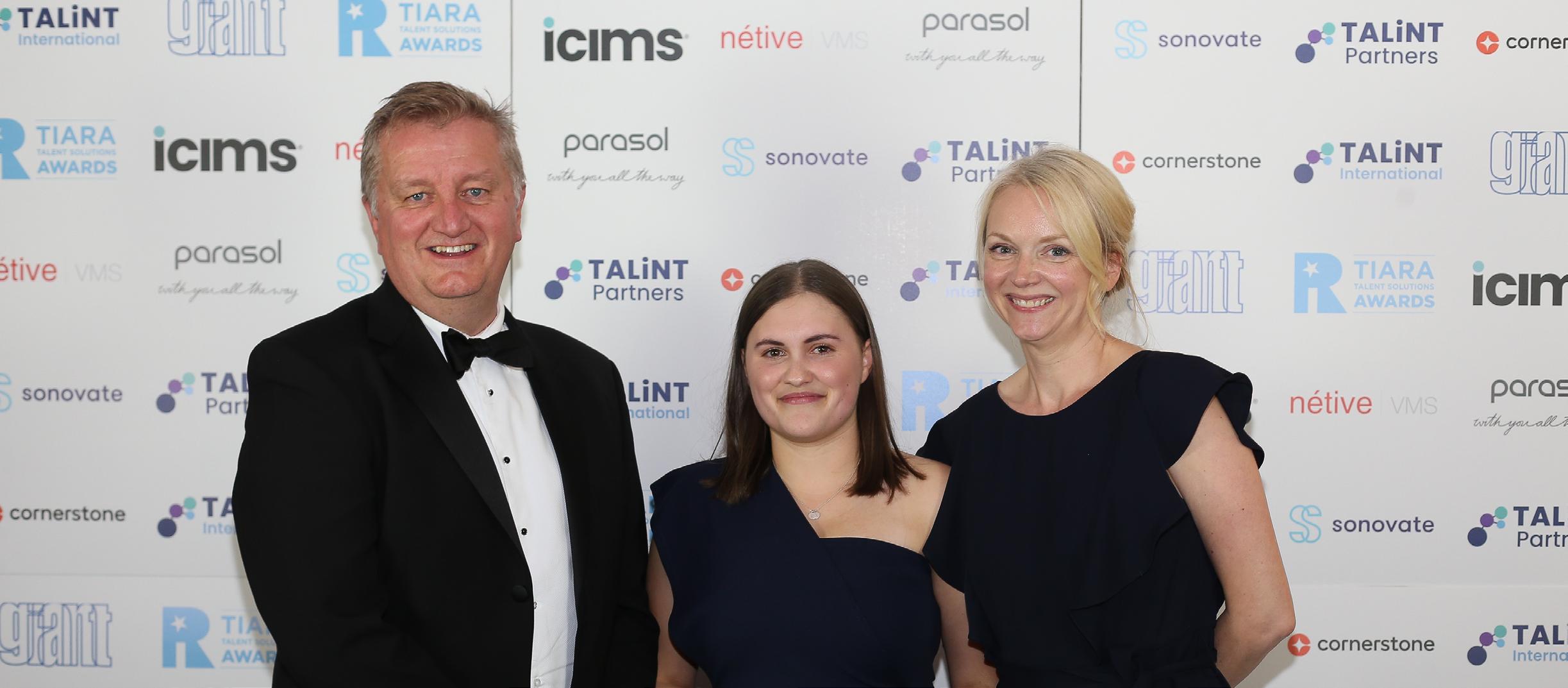
TI: How did the project come about? Did you have a pre-exis�ng rela�onship with NHSBT?
RTS: As a result of COVID-19, NHSBT were tasked with undertaking the world’s largest ever trial of convalescent plasma, crea�ng a research project that would require a large team of ‘donor carers’ and a workforce solu�on that could be implemented at pace.
NHS Blood and Transplant (NHSBT) contacted our Bristol Reed Specialist Recruitment office in August 2020 to understand our capability to support this recruitment project. There was an established rela�onship in Bristol having recruited for their business support and laboratory needs.
Through demonstrating our capability to meet the requirements swiftly, complimented by our experience of managing large workforce solutions and vast
experience of recruiting for the NHS and clients with high compliance needs, NHSBT selected Reed Talent Solutions as their workforce solution provider for this project.
TI: What were the key elements of the brief? Can you briefly break it down?
RTS: Key elements to support the recruitment campaign included: 1. Crea�ng job adverts 2. Agreeing pay rates 3. Designing an inclusive recruitment process 4. Implemen�ng an interviewing team 5. Crea�ng a dedicated website (h�ps://nhsbt.reed.com/) 6. Building and implemen�ng our applicant tracking system 7. Implemen�ng new processes for candidates to receive hepa��s B immunisa�ons
recruitment solu�on that wowed NHSBT and won them the coveted TIARA Talent thrive during the chaos of COVID-19 and navigate the labyrinth of regula�ons they’ll bring to the table for the 2023 TIARAs. They’re the gold standard for DE&I
Reed was asked to recruit ‘donor carers’ across the UK to new and exis�ng donor centres. The ini�al requirement was to fulfil 270 roles in four weeks, increasing throughout the project to over 700 vacancies.
It was essen�al to promote NHSBT as an inclusive employer, representa�ve of the communi�es in which they operate. This core value was at the forefront of all our recruitment process decisions and a�rac�on campaign.

s part of the brief, NHSBT advised that no previous clinical or phlebotomy experience was required to carry out this role, as NHSBT built a robust training plan for the new donor carers to ensure they were safe and
competent to work in a clinical environment. Due to this, it allowed us to engage with a wider talent pool of candidates. As this campaign commenced during the peak of unemployment as a result of COVID-19, we were able to support unemployed candidates back into work without the limita�ons of par�cular work experience being required. We developed an interview and skill tes�ng process that ensured we were providing donor carers that were empathe�c, customer centred and passionate about increasing blood and plasma donors na�onally.
A key objec�ve for the NHSBT was also to increase the diversity of its donors and grow the donor base. With BAME communi�es being more adversely affected by Covid, an immediate challenge for the project was to engage with communi�es and increase BAME doners to support research, treat people and help save lives. To support this, we supported a
laser-focused community engagement programme concentra�ng on diversity and inclusion groups working with religious organisa�ons, and community groups to create partnership campaigns.
The community engagement programme would involve the recruitment of two new roles (faith and belief managers, donor recruiters) for NHSBT to work closely with BAME communi�es to raise awareness and implement long-term rela�onships.

TI: What was most challenging about the brief from Reed’s perspec�ve?
RTS: This was a large-scale recruitment campaign and we had only six weeks to design, implement and deliver the solu�on. What made it more challenging was working under government restric�ons due to the pandemic as well it being a highly regulated environment.
Reed Talent Solu�ons were aware that our �me to implement the service would be challenging.
Reed Talent Solutions and NHSBT needed to work at pace during a pandemic where usual implementation timescales and face-to-face meetings could not be accommodated. Reed Talent Solutions needed to design, implement and deliver the solution at the same time, whilst also building contingency and flexibility in the face of ever-changing government restrictions.
This unpredictability presented new challenges throughout the campaign. Through the use of AI technology and the efforts of a dedicated team, we were able to quickly establish the most effec�ve ways of working to reach a swi� resolu�on at each hurdle.

The clinical environment and pa�ent facing responsibili�es require suitable compliance requirements, as well as hep B immunisa�ons. To ensure we worked efficiently and avoided any unnecessary delays, we engaged our sister company Reed Screening, who were dedicated to driving candidate ve�ng and ensuring full compliance. We also partnered with Superdrug to administer hep B immunisa�ons, where future donor carers were able to simply
book online at their local Superdrug at a �me that suited them.
TI: How did you implement the project? What were the KPIs and �melines?
RTS: Dedicated Resource and Reed Director Level Governance
Reed assigned a project manager to drive the implementa�on of the project. The overall Reed project team consisted of a dedicated account manager, SMEs and key stakeholders across the business, including technology, data analysts, Reed screening, compliance, an NHBST talent acquisi�on team and director level governance across all workstreams and milestones. Due to the importance and complexity of the project, being to increase blood and plasma dona�ons across England to support the ba�le against Covid-19, Reed Talent Solu�ons’ managing director of workforce solu�ons and managing director of con�ngent workforces were heavily involved to ensure the success of the project.
We held a virtual implementa�on mee�ng with NHSBT to understand each party’s role and responsibili�es, project milestones, delivery dates/targets and governance. We agreed regular project checkpoint calls with each stakeholder group as well as overall governance mee�ngs.
The first delivery milestone needed to be achieved within four weeks due to a rise in COVID-19 cases. NHSBT needed to work quickly to have centres up and running for hospitalised pa�ents to receive the treatment as soon as possible. To ensure Reed Talent Solu�ons could meet NHSBT’s delivery needs in the �mescale set, Reed held daily internal mee�ngs with the NHSBT delivery team and Reed screening to monitor the progress of each candidate in accordance with their provisional start date. We had twice weekly mee�ngs between the NHSBT delivery team, the Reed account manager and NHSBT agency liasons to provide updates on the progress of donor carer intakes, any poten�al challenges we were facing, and forecasts for future intakes. This open line of communica�on
allowed for real �me updates and offered assurance to NHSBT that the regular progress was being made. It also allows NHSBT to manage expecta�ons with the hiring managers and training department to ensure training resources could be allocated appropriately.
Through regular communica�ons we were able to work with NHSBT to drive ac�vity against �meframes, manage and mi�gate risk and ensure successful implementa�on.
Our project managers stayed closely linked to the project a�er the first three months of delivery by con�nuing to a�end the stakeholder mee�ngs to ensure the solu�on designed and implemented was efficient and mee�ng NHSBT’s needs, as well as offering different arms of Reed Talent Solu�ons workforce solu�on channels to expand the service we could offer. With the speed in which the project was scaling, it allowed for immediate ac�on to overcome any challenges NHSBT or Reed may have faced.
Within the first four weeks, Reed were required to deliver 270 donor carers across the UK. To deploy a candidate, the candidate needed to complete an ini�al pre-screen, pass two online skills tests, complete a competency-based interview and ini�ate and complete the compliance process. All a mammoth task for an
individual, and Reed were challenged with comple�ng this for 270 candidates plus con�ngency in 20 workdays. To ensure this was deliverable for Reed and NHSBT’s training team, we split the loca�ons by cohorts based on the resources available across each donor centre. We exceeded this target by delivering 340 donor carers in the first four weeks, which was welcomed by NHSBT.
Within five months, we had designed, implemented, delivered and expanded the service we provided to NHSBT. The service has resulted in over 700 members of staff being deployed into the NHSBT teams. This represents a 12% increase in the en�re NHSBT permanent workforce, further demonstra�ng the impressive scale of the project, the process and the partnership in place to achieve these results.
TI: How did you measure success? What metrics did you use?

RTS: The metrics we used were fulfillment of vacancies, repor�ng and EDI&B and candidate and customer sa�sfac�on.
We are proud to have found success across every aspect of our work with NHSBT. However, fulfilment of the vacancies and finding the best talent was the ul�mate success measure. Having commi�ed, trained and ve�ed donor carers was fundamental to the func�onal opera�on and to pa�ent safety in each centre.
RTS successfully filled 100% of all requirements, on time.
As a result of the partnership, we successfully ran the largest ever trial of convalescent plasma. RTS managed the en�re recruitment process, suppor�ng 700 donor carers to be deployed across new and exis�ng sites, providing the best pa�ent care while delivering vital healthcare intelligence for the scien�fic community and increasing NHSBT’s capacity to collect plasma and blood dona�ons.
NSHBT emphasised increasing BAME and youth representa�on. An inclusive working environment has been at the forefront of our service, deploying inclusive adver�sing and assessment processes, scored against a preagreed criteria to support open and fair decision making.
Overall, our strategy enabled us to posi�vely impact on workplace diversity.
• BAME donor carers increased to 25% compared to a 15% average.
• Donor carers under the age of 45 increased to 58% compared to a 40% average.
Through the people we recruited and the efforts undertaken by both Reed and NHSBT we were delighted by the results, which included recrui�ng 80,000 donors, increasing BAME engagement, developing capability to collect plasma across 22 sites, hiring and training 1,700 staff and engaging with 14,000+ pa�ents to CVP trials.
TI: In such a massive project, there were bound to be bumps in the road. What were the main challenges faced and how did you overcome them?
RTS: An extended part of Reed Talent Solu�ons brief was the niche recruitment for new roles. As part of the focused community engagement programme, NHSBT required Reed to source faith and belief managers, who would work closely with BAME communi�es to increase awareness of blood and plasma dona�on and develop long-term partnerships with larger organisa�ons to promote NHSBT, as well as have exis�ng rela�onships with local faith and community groups.
We adopted a ‘head-hunt’ approach to source suitable candidates for these posi�ons. We worked with our wider teams and drew on our experience of recrui�ng similar roles within our police contracts.
Alongside the faith and belief managers, Reed were asked to source ‘donor recruiters’, who would be responsible for working closely with NHS organisa�ons and the wider community to increase awareness of the dona�on of convalescent plasma from people who have recovered from COVID-19. As this was a new role, Reed Talent Solu�ons supported NHSBT in the end-to-end recruitment design, a�rac�on and interview process as well as providing advice on pay rate benchmarking.
Throughout the project we measured sa�sfac�on through our chatbot surveys and open communica�on channels including dedicated NHSBT email and phoneline.
One hundred percent of the responses received within the community engagement programmeconfirmed a posi�ve service.
Reed Talent Solu�ons implemented this process and successfully recruited 12 posi�ons all within three weeks. Due to the pace in which we were able to support, we were then asked to recruit a further 35 donor recruiters within a six-week period in new loca�ons across the UK. Whilst we had designed a recruitment process, we were now adver�sing in new, harder to fill areas.
RTS and NHSBT needed to work at pace during a pandemic where usual implementation timescales and face-to-face meetings could not be accommodated.
Due to internal workforce pressures, NHSBT advised Reed Talent Solu�ons that they would be unable to accommodate more than one intake, meaning we would need to recruit for all areas and vacancies in just two weeks. We sought support from our internal Reed network in order to deliver against the challenging deadlines. Our increased resources and focus to the posi�ons meant that we were able to successfully deliver all 35 requirements within the shorter �meframes
TI: What was the feedback from the client? And how did you build on it?
RTS: Overall, the feedback from NHSBT was complementary of our ability to source and deploy volumes of candidates under the �me pressures put in place. We o�en received unpromoted feedback sharing their apprecia�on of our partnership to aid research to ba�le COVID-19, and shortly a�er plasma for medicine.
TI: What’s next?
RTS: EDI&B is part of a talent acquisi�on programme which con�nues to mature. The strides that companies and talent solu�ons providers have made over the last five years in par�cular means there are best prac�ces and lessons to be shared. We are really pleased that organisa�ons are now able to look at deploying an EDI&B strategy in a much more meaningful way and looking at diversity as much more than race and gender, with the inclusion of the aged workforce, the LGBTQ+ communi�es, the disabled popula�on and more recently the social class backgrounds.
What is clear is that there is not a one size fits all approach. Different organisa�ons have different challenges, different customers, different loca�ons. But with confidence and commitment to se�ng an EDI&B strategy that ensures you are a good corporate ci�zen and it benefits your business then it’s a win win.
The staffing sector has got to con�nue to review the recruitment process and challenge all parts of the process, including the technology providers to ensure that the candidate experiences are as inclusive as we need them to be. Becoming digital and efficient has obvious benefits, but let’s not undo all the
good work over the years to bring EDI&B as a priority in talent acquisi�on.
TI: And finally, are you going to be entering the TIARAs again in 2023? Why?
RTS: Yes, we very much value the partnership with our clients and the awards give us a great opportunity to take �me out to reflect on what we have achieved together. We also appreciate the feedback post the awards from Talint on the strength of our submissions and take the opportunity to benchmark our services and improve where necessary.








TALiNT Interna�onal sat down with Ged Walsh, Everpool Recruitment MD, to hear his thoughts on the industry, business growth and recession proofing your business.

In a year where confidence in the economy has fallen and with more job vacancies than candidates, it’s temp�ng to cut costs and reduce staff, but Ged Walsh, MD of Everpool Recruitment, is poised to ride the storm – building a robust profitable company with aspira�ons of trebling in size, expanding into new sectors and posi�oning Everpool as one of the UK’s top 50 recruitment companies - 2023 is just the beginning.
Everpool Recruitment, based in Liverpool, was established in 2021 after demerging with Meridian Business Support. It is an independently owned national recruitment company specialising in healthcare in

both the public and private sectors, and despite being in business for just over a year, they’ve already placed over 500 candidates in jobs. Everpool have now opened legal, accountancy and finance and office and commercial divisions.

TI: With so much economic uncertainty, how do you plan to future-proof your business?
GW: This year, we want to grow the business – with sales and people. I want it to treble in size and become one of the top 50 recruitment companies in the UK. We want to diversify into new markets and increase business sales. In 2022, our target turnover was £2.7 million; this year we are aiming
for £4 million and in 2026, the projected total is £5.5 million. Our head count has increased from 18 in Oct 2021 to 32 in 2022. We’re expanding our square footage from 2,100 to 4,000 square feet, which means we can increase our headcount from 32 to 50 in the next 3-5 years.
We plan to further expand our newest sectors: legal, accountancy/finance and office and commercial. Succession planning is key. We’re looking to bring on a senior person to help grow the business and bring in some senior recruiters in the areas we are looking to expand in.
TI: What advice can you give to other SME recruiters on how to recession-proof their business?

GW: In a recession, it’s important to analyse all costs and ask, What are we spending, are we ge�ng a return on our investment and are we tracking that? What you o�en find is there will be certain things you are spending on that you don’t need, and you could be pu�ng that cash into something else that could be more valuable to you. You must ensure that in recruitment, your staff are engaged and it’s important to be flexible. Carry out wellbeing surveys and focus on your exis�ng staff, making sure they stay with you, that’s key. You also need to make sure that your marke�ng is where it needs to be, looking at your website, systems and procedures to ensure you are moving with the �mes digitally in an ever-changing world.
TI: So, what are your plans for 2023 and beyond?
GW: As men�oned above, we’re focussing on growing staff numbers and reach. But amongst that, we aim to maintain our core values of integrity and honesty, increase office space and build skill bases.
We’re passionate about internal mobility, so we will strive to ensure that our people can learn and grow their careers by focussing on ongoing training and development.
Diversity and inclusion is at the heart of everything we do, and we will ensure our DE&I policy con�nues to underpin our growth in the coming years.
TI: With a turbulent economy, how are you weathering the storm?
GW: There will always be opportuni�es to recruit, you must watch the market. Now, it’s an unusual market, with economic instability, Brexit
and poli�cal chaos. Fortunately, the pandemic didn’t change much for us as we kept our core clients and big contracts. Moving forward, we want to make our business robust and we’re looking to move into interna�onal markets, recrui�ng clinicians to the UK from abroad and vice versa.
TI: Ged, you’ve been in recruitment for 20 years, this must be a huge advantage?
GW: I decided to move away from a larger company and build a more robust, agile business around quality of service, which has fundamentally made a difference. It’s good to know your industry inside and out. I’ve worked in retail, legal and the health and social care sector - it’s about understanding people and ge�ng a real feel for the business.
TI: How would you describe the current state of the recruitment industry?
GW: At the moment, the candidate is king and new job adverts remain at an all-�me high. For the first �me since 1974, there are more vacancies than candidates. It’s a candidate-driven market, but this might change in a turbulent economy, with a looming recession and redundancies on the horizon. Permanent vacancies are s�ll robust, and candidates can push for pay, flexible working hours, bonuses and incen�ves. They are asking the employer, ‘What have you got for me?’ as much as employers are looking at what the employee can offer them.
TI: What makes a successful recruitment company?

GW: Firstly, understand your clients’ needs, what they do, their culture, values and long-term goals and from there
find a good fit. Our business is wrapped up in four main clients and we want to grow that. What we must do this year is to become more robust by diversifying into these exis�ng sectors and moving into new ones. It’s a challenge, but it must be done. If you are delivering for your clients, they want to give you more business. It’s about educa�ng our clients to find the right candidates. The key to delivering to clients is ensuring you’re adding value to the opera�onal side of the business in terms of trading, training and engagement.
TI: Everpool was founded in Liverpool; how proud are you of your Liverpudlian heritage?
GW: A�er demerging, we needed a new name that reflected Liverpool. We came up with ‘Everpool’ because we’ve an ‘infinite pool’ of candidates and you can see this in our logo. It’s also a play on words with
‘Ever’ from Everton and ‘Pool’ from Liverpool. I am a proud Evertonian and I can tell you it’s the first �me Everton will have been in front of Liverpool for a long �me!
TI: A solid company culture and employer brand, as well as employee wellness was in sharp focus in 2022. Going into 2023, how can you ensure you have a happy and successful team?
GW: Our mission statement is: ‘Empowering people to achieve through togetherness and community spirit by winning hearts and minds to serve our clients.’
It’s about people enjoying coming to work. We want our staff to grow with help and support, ensuring we are flexible. We have lots of working mums and dads and we value them. If they’re experienced workers, we encourage them to work their
hours whenever they want, from home or the office. This gives them �me to take their child to nursery or go to the gym and then come to work. We’re also inves�ng in our people, and we’ve put all our consultants on a Business Development Fundamentals course, using an external training company. I feel lucky to have my team and find that having trust promotes confidence and the rest flows really.
TI: How would you describe Everpool’s work culture?
GW: Agile, innova�ve and meritocracy – in our company, there’s no reason why someone at a junior level can’t rise to being an account manager. Our external HR consultants carried out an Employee Wellbeing Survey in October 2022 and 13 out of 15 ques�ons scored ‘highly mo�vated and engaged’. The most used words to describe Everpool’s work culture were, ‘supported’,
‘teamwork’ and ‘friendly’. Our independent HR consultancy firm said Everpool was the most open business they had ever come across. As a recruitment agency, we must prac�se what we preach. In the survey, we asked our team what they wanted, and we listened. We reduced their working hours from 42 to 37.5 hours per week and gave them a pay rise – this went down very well!

If you don’t look after your people, you lose them. I believe in empowering rather than telling, we focus on coaching and take pride when others succeed. We want to continue to be a harmonious office...
TI: You say Everpool works because it’s a meritocracy. How does this work in prac�ce?
GW: We try to get the balance right; the environment isn’t rigid. Some of our team members come from call centre backgrounds, where they are �ed to their desks and monitored every minute. We believe in freedom of choice. For me, we work on having the right culture and behaviours and this results in success. We constantly talk about ‘good news’ and if one of us wins, we all win. We never argue about fees, we split them accordingly; everyone is happy to split fees. If you are the account manager and someone in your team fills a vacancy, they get 75% and you get 25%. Anyone can bring
an account on at any level. You can go from being a trainee to account manager to a team manager. If you’ve delivered, you can self-promote.
TI: Staff reten�on is key in the current market. What do you do to ensure your staff stay?
GW: If you don’t look a�er your people, you lose them. I believe in empowering rather than telling; we focus on coaching and take pride when others succeed. We want to con�nue to be a harmonious office and to be agile and crea�ve, developing our own talent with good internal mobility. We will also con�nue to develop our equality, diversity and inclusion policies and embrace diversity by suppor�ng colleagues who are neuro-diverse or have a
disability. Every fortnight, we hold one-to-one mee�ngs with line managers, so there shouldn’t be any big surprises.
This year, we are launching our ‘make a difference’ campaign where staff can email any ideas of how they think they, or something posi�ve, can make a difference to the company.
TI: What place does tech have in your industry?
Our industry will always be led by people first, and I don’t think this will ever change. In a restaurant, would you rather be served by a robot or a waiter? You just can’t beat the human touch, especially in our industry. People are the essence of what we do.
The importance of diversity, equality and inclusion (DE&I) has become more apparent within corporate agendas for many years; however, there is no doubt it came to a head in May 2020 following the murder of George Floyd. The outpouring of anger and empathy from across the world shook the founda�ons of corpora�ons globally. Companies promised introspec�on and poured billions of dollars into programmes designed to address bias in hiring prac�ces and commi�ed to improving DEI across the board.
Two years on, organisa�ons should be able to assess whether DE&I strategies and programmes are bearing fruit. Yet Ceridian’s 2022 Execu�ve Survey suggests inten�ons o�en don’t o�en align with ac�ons. Ninety percent of respondents report their organisa�on has a DE&I strategy. But only one-third say progress is being made in this area and only 19% say their organisa�on is a leader in DE&I.
Perhaps a significant contribu�ng factor to this has been the pandemic. In �mes of uncertainty and when naviga�ng disrup�on, the natural thing to do is focus on business con�nuity. Within the context
of COVID-19, implemen�ng DEI strategies with clearly ar�culated measurable outcomes in the workforce may have taken a back seat. Across the UK, some DEI regula�ons were temporarily removed –such as the annual mandatory gender pay gap repor�ng – to help struggling companies to cope, for example.

Despite these challenges, the Harvard Business Review, in its analysis of S&P 500 earnings calls, found that since 2018, the frequency with which CEOs talk about DEI rose by 658 percent. Authen�c, trusted leaders are the proven winners in crea�ng cultures that a�ract and retain their staff. DEI is becoming a benchmark by which all employees can scru�nise whether their employer does what it says it will do, or whether it’s paying lip-service to it. Now is the �me for organisa�ons to implement their strategies, with a focus on measurable outcomes and quan�fiable performance metrics for ongoing evalua�on and refinement.
LinkedIn’s Global Recrui�ng Trends report found that diversity is a key trend that has impacted the way organisa�ons hire their
people. According to the report’s findings, 78% of companies priori�se diversity to improve culture, and 62% of companies priori�se it to boost financial performance. This is a welcome shi� in repor�ng.
Tradi�onally, DEI has been measured in terms of self-disclosed demographic data, which makes it unlike how we measure any other area of business.
For example, within sales, the performance of a campaign is measured against straightforward KPIs (key performance indicators). The challenges of running a sales campaign without having a goal and knowing how many deals have been closed is obvious to all. In a similar fashion, organisations need to approach challenges that touch every aspect of diversity, equity and inclusion in the same way they solve problems in every other aspect of their business.

Finding the root cause of bias is the crucial place to start, which can be determined by measurement. Although technology can make DEI measurement easier, it’s not essen�al to start.
General Manager, Talent Intelligence, Ceridian
My �ps for any organisa�on, big or small, beginning this journey are to:
1. Get a concept of demographics: Look at who is being hired and promoted and start building measurable demographics for each person on aggregate. Ini�ally, these can include the most common poten�al biases – race, gender, age – but as an organisa�on becomes more sophis�cated can include educa�onal a�ainment, childcare responsibili�es, etc.

2. Work out conversion rates: With the above informa�on in hand, one can see how the conversion rates differ between talent goal posts. For example, it may show that women with children are being promoted exponen�ally less than those without. With sta�s�cal informa�on on this, leaders can then make value judgements about what to do about it. For example, to subsidise day care.
3. Facilitate ongoing feedback: Ceridian’s 2022 Execu�ve Survey suggests employees don’t think progress in DEI is being made. By deploying, for instance, pulse surveys across the workforce, leaders can arm themselves with the informa�on they need to make more informed decisions to help reduce or eliminate pa�erns of discrimina�on on a regular basis. Anonymous feedback, par�cularly when we see inclusion from people at an entry-level role all the way up to the C-suite, can help build a case to take on immediate ac�on across smaller, but pressing issues, as well as inform long-term strategies. Crucially, they give organisa�ons a measurement pla�orm to start with.
We’ve seen many clichés about how data is key. But it’s a cliché for a reason. HR teams are often small in headcount yet responsible for a vast trove of information: payroll, timesheets, interview scheduling, and more. Making sense of that data manually is an enormous task that often requires a skillset that may not be present in most HR departments.
In the past few years, we’ve seen AIpowered DE&I solu�ons connect within an organisa�on’s different systems to drive intelligent recommenda�ons in a way previously unimaginable. These pla�orms use a combina�on of self-disclosed demographic data and inferred demographic data to ensure equity and fairness through all stages of the talent decision-making cycle. This methodology is used to uncover inequi�es in both human and automated decision making to make fairness and DE&I a core principle of design, rather than an a�erthought.
Crucial to successfully implementing artificial intelligence into HR and recruitment is that results are explainable. The decisions made are so important that it’s critical HR teams can understand exactly how an algorithm is making a decision and a recommendation. For AI to work in DEI it needs to be transparent, externally validated and completely defensible.

I����� �� ��� ������ ����
The business case for DE&I has never been stronger. Our research revealed that respondents see DE&I strategies as allowing them to be more innova�ve (35 percent) and adaptable (34 percent). The only way that organisa�ons can move beyond paying lip service to diversity, equity and inclusion is to start measuring the impact of schemes, responding and delivering the resources needed to change.
Event
Optimising
TA
Audience
Staffing and Talent Solutions Leaders
Talent Acquisition Leaders APAC Staffing and Talent Solutions Leaders

Date Mar Event Name Audience Location Date
European
TALiNT
Staffing and Talent Solutions Leaders
Talent Acquisition Leaders EMEA

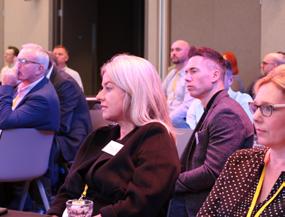

Staffing and Talent Solutions Leaders

Talent Acquisition Leaders APAC
Talent Acquisition Leaders
Talent Tech Leaders
Talent Solutions Leaders
Talent Acquisition Leaders
Talent Solutions Leaders
Virtual
The King’s Fund, London Virtual Frankfurt
The King’s Fund, London Virtual London London
The Ivy West Street, London Manchester London

 Ken Brotherston
TALiNT Partners CEO
Ken Brotherston
TALiNT Partners CEO
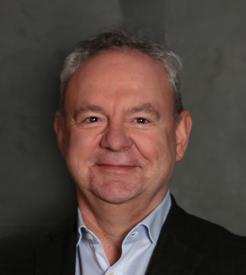
As we return hopefully refreshed, relaxed and reinvigorated for whatever 2023 has in store for us, I start my first TALiNT Talk of the year with reference to my last one of 2022 (Reasons to be cheerful).
Despite the seemingly unending diet of gloom from the media, I s�ll believe that 2023 will not be as bad as many seem to think. I’m not alone in this view, economic commentators from far more august publica�ons than this one seem to have a similar opinion.
However, one challenge that is certain to con�nue for 2023 is the tension between the economic agenda and the talent agenda. Research from The Times CEO Summit and Deloi�e summarised the concerns as: return to the office, skills, infla�on and poli�cal instability (local and global).
So, in the short term, how this is likely to manifest itself for HR and TA leaders is the challenge of ‘doing more with less’. The talent agenda isn’t going to be less of a priority any �me soon but the pressure on budgets will make this another challenging year.
Those who took the opportunity to invest immediately post pandemic, whether in be�er technology or be�er people, will be be�er placed to deal with whatever lies ahead. As will those organisa�ons who embraced opportuni�es to design new, more dynamic and flexible ways of working and aligned this with a post-pandemic employer brand refresh.
Nevertheless, the ‘less with more’ mantra will be a challenge for everyone. The staffing sector will generally find more pressure on fees than in recent years (with a few ‘hot sector’
excep�ons); RPO and MSP providers will be challenged to be more agile and flexible and to deliver be�er service levels and talent tech providers will need to demonstrate both rapid product effec�veness and clearer ROI than in recent years.
For TA and HR teams, two things will help them not just cope but improve: prioritisation and Talent Intelligence (TI). The sheer range of activities for TA teams can seem overwhelming – planning, sourcing, attracting, assessing and engaging are all important but knowing which area is going to deliver the biggest and/or quickest return is key. And this leads neatly into the second point: the use of talent intelligence. Whilst many organisations have been using TI in various ways for some time, overall, this is still a nascent skill for too many TA and HR execs. No longer. Using TI to support isn’t a
nice to have, it is an essential entry ticket for discussions with any board or exec team and the ways it can be deployed are growing rapidly. Here at TALiNT Partners we will have a lot more to say about this in 2023.
So, there you go. This year is going to be an interes�ng year – challenging in many ways, but not nearly as bad as we feared. The skills and talent agenda will con�nue to be front and centre crea�ng lots of opportuni�es to shine and showcase the amazing capabili�es of those of you who make this your profession.

Connec�ng the talent ecosystem: we bring together a global network of leading employers and solu�on providers to make be�er talent and technology decisions.
